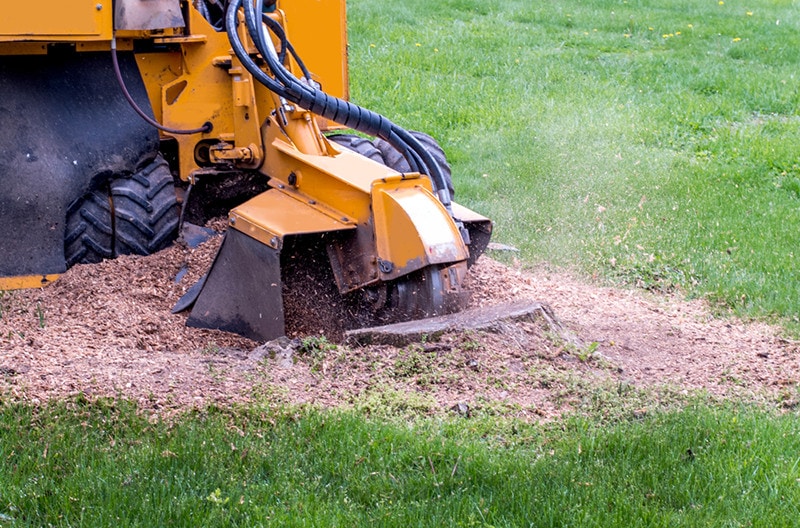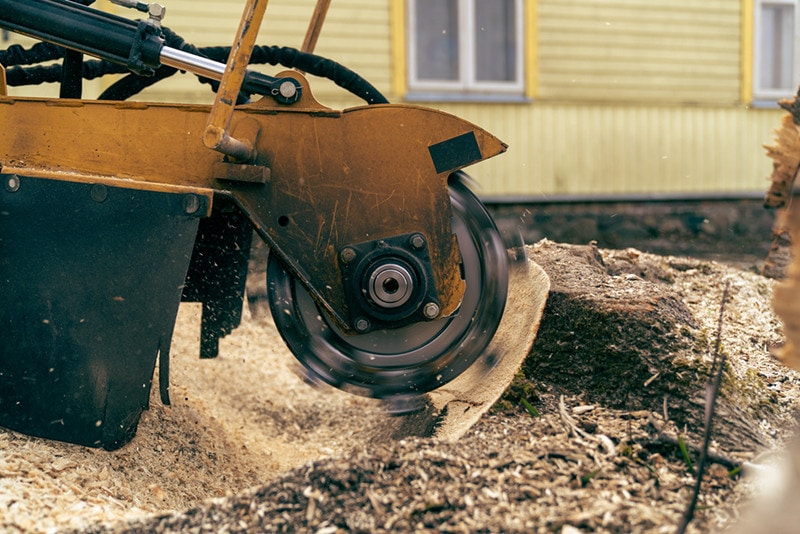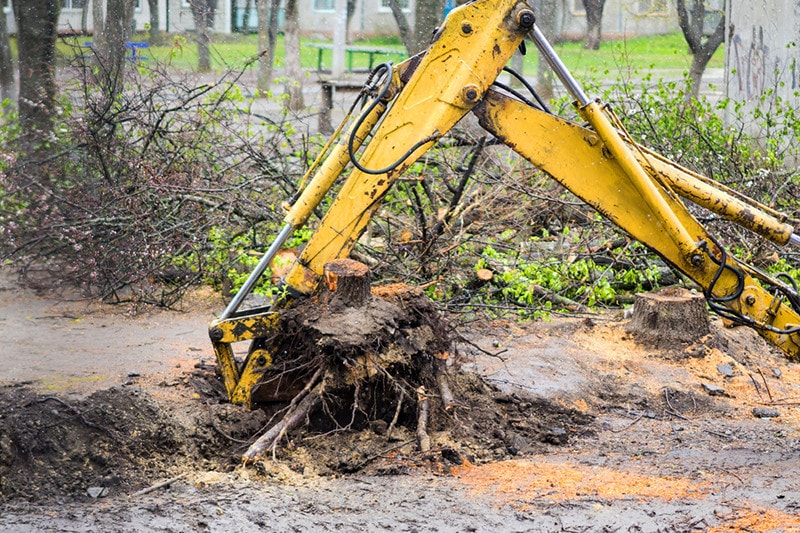What Happens to Roots After Stump Grinding? The Interesting Answer
-
Pete Ortiz
- Last updated:

Once a tree has been cut, the remaining stump may seem like an obstruction or a danger to your children and pets. Therefore, stump grinding may be the only solution. However, stump grinding does not fully eliminate roots from the ground.
So, what happens to the roots after the stump grinding process? Stump grinding does not get rid of tree roots. Read on to find out.
Where Do the Roots Go After Stump Grinding?
Stump grinding will only eliminate the upper part of the stump and leave the roots intact in the ground. Whatever happens to the roots after stump grinding is often related to the fertility of the soil, nutrient-rich in the soil, and if the soil is left undisturbed.
Below are the possible outcomes for the roots after this process:
1. The Roots Will Decompose

Some roots will begin to decompose and eventually form perfect manure in the ground. Most people may use the same spot to plant some flowers, which will flourish due to the available manure.
2. The Roots Will Sprout
Stump grinding does not mean the roots are dead; they often live for some time and then decompose or sprout. Roots from aggressive trees will not decompose without a fight. Usually, such roots will begin to sprout, especially if the soil is fertile and has enough moisture.
They will try as much as possible to survive and even regrow before they finally decompose. If they are not uprooted on time, the sprouts may again grow into larger trees.
3. Some Roots Spread Horizontally
Roots belonging to species like elms, maples, oaks, crepe myrtles, willow trees, Chinese Pistache, and poplars may spread horizontally. Their aggressive nature may cause damage to nearby pipes and foundations.
4. The Roots May Grow Further Into the Soil
When the soil is loose, the roots may grow downwards, heading deep into the soil. This happens when the roots still have the illusion of supporting an existing tree. How deep the roots grow into the soil also depends on the type of tree they belong to.
Roots of trees like oaks and maples are prone to growing much deeper into the soil in search of water and nutrients to support the growth of the trees.
The Process of Stump Grinding

Although you could hire professional tree care specialists to do the entire work for you, stump grinding is a straightforward process you can do on your own.
All you need is a stump grinder, eye protection, earplugs, a shovel, and a wheelbarrow.
Unless you are a professional tree-cutting specialist, you may not have all the above items in your possession. It would help if you rented some or at least all of them. None of the items is of less importance than the other, therefore, do not imagine that you can grind a stump without needing earplugs. In the same way, a grinder is very important to the process, the same way earplugs and eye protection are.
Once you have all the requirements, place the grinder over the stump that is to be eliminated. Turn the grinder on and slowly begin to move it towards the stump. Once it reaches the stump, the grinder’s sharp rotating blades will continue to chip away at the stump until it is flat on the ground. Remember to take your time during the process; when your grinder is moved too fast, it may begin to stop working abruptly.
You will be left with excess wood chips on the ground when you grind. Use your shovel and wheelbarrow to ensure they have been disposed of properly.
How Long Does It Take Roots to Rot After Stump Grinding
The amount of time it takes for roots to completely decay after stump grinding varies depending on the species of the tree. Some trees have persistent roots and can survive for years without rotting, while others begin the decomposition process immediately after stump grinding. Also, roots in warm climates start to deteriorate rapidly due to the activity of bacteria and fungi in warmer soils.
Suppose you would like to accelerate the rotting process of the roots after stump grinding, allow the roots to sprout and grow up to about 1 foot high and chop them off. Cutting off the sprouts at this point depletes the nutritional sources of the roots, causing them to rot much faster.
Alternatively, you can use Epsom salt or rock salt to hasten the decaying process of the roots. Make sure to use the expected amount, as too much of its nutrients may cause more harm than good to the soil and other surrounding plants.
How to Prevent Regrowth After Stump Grinding

As earlier confirmed, roots may decompose or grow again depending on the type of tree, the fertility of the soil, and the existing nutrients. However, there are possible solutions to sprouting after stump grinding, as illustrated below.
Constantly Remove the Sprouts
Do not give the sprouts a chance to grow. The moment you notice their existence, ensure to chop them off from where they meet with the roots. Repeated removal of the sprouts weakens the roots, and eventually, the roots decompose.
Use Herbicides
Herbicides are helpful when you have no other plants or trees growing next to the stump. While they may stop the roots’ sprouting, they may affect the growth of other plants that you had not intended to cut. Therefore, it is advisable to use herbicides only when you do not need other plants close to the stump or when the stump has no other plants nearby.
Use Concentrated Salt
Concentrated salt like Epsom is a more natural way of eliminating regrowth after stump grinding. The salt may not work as fast as an herbicide, but it will kill the roots after continuous use.
Seek Professional Help
Call a professional tree care organization well-equipped to eliminate a stump with a grinder. They will also ensure that the roots are taken care of so that there will be no possible sprouting after they finish their work.
Stump grinding may be a straightforward DIY project, but you may need professional help to ensure no regrowth takes place a few months or years after the process.
Can You Replant a Tree After Stump Grinding?
You may cut down a tree, thinking it was the best decision for your space, only to regret your decision and wish to replant another tree in the same spot. The answer to your question is yes, you can replant a tree after stump grinding. However, the following conditions must be met.
Eliminate the roots of the previous tree

The existence of the previous tree’s roots will not allow the new tree to grow efficiently in the soil due to a lack of space and competition for nutrients. Therefore, consider uprooting the roots completely. Call for professional help to uproot the roots, remove the sprouts, and use herbicides or concentrated soil. Choose your method depending on how soon you want your tree planted.
Consider the previous type of tree
Some types of trees, like walnuts, produce toxic secretions in the soil that can prevent other types of plants from growing effectively. In such a situation, you need to find a solution for the toxins or consider changing the location where you want to plant your next tree.
Restore soil acidity
Once tree roots begin to decompose in the soil, the decomposition alters the acidity of the soil where the tree existed. The altered acidity levels may prevent the efficient growth of the next tree.
Benefits of Stump Grinding
When a tree is cut and left in the middle of your backyard, it may look out of place. Children and pets may stumble over it and even sustain severe injuries if care is not taken. However, after stump grinding, the space becomes even, neat, and safer.
Stump grinding also regains lost space. A stump may take up much space in your backyard, but once it has been ground, there is enough space for your family members to enjoy outdoor activities.
Also, after cutting down a tree, pests like ants may create a home for themselves on the remaining stump. Some pests are dangerous and may cause serious bites and infections. Stump grinding will eliminate the possibility of pest infestation.
Conclusion
After stump grinding, roots will decompose, sprout, spread horizontally or grow further into the soil. When the roots survive in the soil after stump grinding, they may last for years, depending on the type of tree, the place’s climatic condition, and the land’s fertility.
Also, stump grinding does not mean you cannot regrow a tree in the same spot. A tree will grow as long as you eliminate the previous tree’s roots, consider the last tree’s toxic level, and restore soil acidity.
See also: How Deep Do Tree Roots Go? What Does It Depend On?
Featured Image Credit: Susan B Sheldon, Shutterstock
Contents


